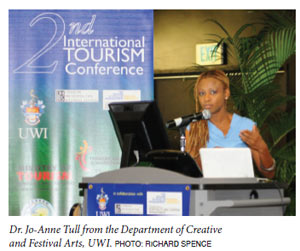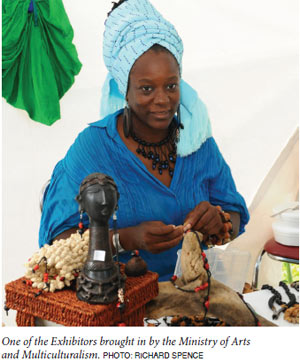|
March 2012

Issue Home >>
|

The Caribbean has long been attractive to those who seek sun, sea and sand. But sun, sea and sand no longer offer a competitive advantage. Too many destinations offer the same amenities, and consumers are more interested in acquiring unique and memorable experiences. New ways have to be found to lure tourists. One such way is through food, the growing niche market of culinary tourism.
The Acorn Consulting Partnership, in a report prepared for the Caribbean Tourism Organization, defines niche tourism marketing as a specific market segment that can be tailored to meet the interests of the customer.
Culinary tourism, which describes travellers who visit an area specifically for its food, is a growing tourism market that has the potential to generate millions of dollars in the economy. It includes food festivals, cooking schools, wineries, restaurants, visits to farms (local markets), food shows, and epicurean retreats. This type of tourism, already popular in the restaurants of Vietnam, Thailand, Canada, and other nations, is growing in the Caribbean, but not at the rate of its potential.
Caribbean tourist destinations recognize the importance of food to Caribbean culture and the need to promote something more than the sun, sea and sand, but need to invest in creating a new niche for cultural tourism that can diversify their tourism product.
 Niche tourism marketing is not new to the Caribbean. The Caribbean offers a wide variety of cultures, which is evidenced in the diversity of food on the different islands. This diversity is due to the historical connections with Africans, Chinese, Indians, Spanish, English, French, Germans, Middle Easterners and Dutch. The variety of different ethnic foods and the increase in the interest of different foods, allows for a perfect marriage of food and tourism in the Caribbean in the form of niche tourism marketing. Niche tourism marketing is not new to the Caribbean. The Caribbean offers a wide variety of cultures, which is evidenced in the diversity of food on the different islands. This diversity is due to the historical connections with Africans, Chinese, Indians, Spanish, English, French, Germans, Middle Easterners and Dutch. The variety of different ethnic foods and the increase in the interest of different foods, allows for a perfect marriage of food and tourism in the Caribbean in the form of niche tourism marketing.
Culinary tourism became popular as the steady increase in interest in food channels, travel shows featuring local and regional cuisine, food documentaries and online culinary travel shows, and recipes, prompted more consumers to visit destinations specifically to avail themselves of a new food and wine experience. Erik Wolf, president of the International Culinary Tourism Association, has defined cultural tourism as “the pursuit of unique and memorable culinary experiences, often while travelling.” His definition does not restrict culinary tourism to travel far from home, but include such activities as “trekking across town to try out a new restaurant.”
In an unpublished thesis, “Food Tourism and the Culinary Tourist,” Sajna Shenoy identified five dimensions (activities) of culinary tourism, which include: dining at restaurants known for local cuisines, purchasing local food products, consuming local beverages, dining at high quality restaurants, and dining at familiar chain restaurants and franchises. Shenoy described the culinary tourist as the tourist who, at the destination, frequently dines and purchases local food, consumes local beverages, dines at high-class restaurants, and rarely eats at franchised restaurants. In addition, the culinary tourist segment was more educated, earned higher income and was characterized by its variety-seeking tendency towards food.
Culinary tourism in the Caribbean is generally associated with food festivals. The Caribbean has a long-standing tradition of food festivals that target the natives. This practice has been extended overseas where Caribbean festivals, with a strong emphasis on food from the islands, are held in major cities worldwide. These festivals mainly attract Caribbean expatriates living in the cities and surrounding areas, but in recent years have been promoted to the larger population in those areas. Islands that are dependent on tourism can use festivals as an opportunity to capitalize on the culinary tourism market. Some islands, such as St. Maarten and Barbados, recognize the benefits of the new niche in culinary tourism and are promoting their countries as the top food destinations in the Caribbean. However, other islands, such as Jamaica and Puerto Rico, are beginning to use food to attract the tourist, but have not tracked the success of the promotions.
Festivals were one of the niches identified in the Acorn 2008 report.
All of the countries identified were listed as having a niche festival market. In the Caribbean, over 100 festivals are held annually. However, the music festivals some of which showcase food, are the ones mainly promoted to foreign tourists, while the food festivals are particularly designed for local residents. Tourists are always welcomed, but these festivals are not usually promoted externally. Yet, the tourists who attend these festivals can be used as an effective conduit for word-of-mouth promotion. In addition, there are numerous globally held Caribbean festivals, such as the Jerk Festival, that promote Caribbean food. The festivals expose different people to the food and culture of the Caribbean and serve as a good market place for Caribbean immigrants in different parts of the world.
 Trinidad and Tobago’s annual carnival is a strong draw for returning natives and a large number of tourists who return each year not only for the music but also for the local cuisine. Other islands such as St. Maarten, Jamaica, Barbados and Puerto Rico are including festivals in their promotional communications. They are creating a niche that focuses on the tourist that travels for food. Trinidad and Tobago’s annual carnival is a strong draw for returning natives and a large number of tourists who return each year not only for the music but also for the local cuisine. Other islands such as St. Maarten, Jamaica, Barbados and Puerto Rico are including festivals in their promotional communications. They are creating a niche that focuses on the tourist that travels for food.
The promotion of food or culinary tourism in the Caribbean is relatively new and is usually included in the promotion of the local festivals. In nineteen of the twenty-three countries, based on the profile presented in Acorn’s report, culinary tourism is already available. However, the report cautioned that the level of product development and sophistication varies. More is needed to promote culinary tourism in the Caribbean.
In comparing the culinary activities in the Caribbean, I focused on the islands of St. Maarten (promoted as the top culinary tourist destination in the Caribbean), Jamaica, Puerto Rico and Barbados. I tried to identify the promotional activities of the four islands to assess the cultural tourism gaps in the promotion of the destinations.
I looked at the islands’ official websites for culinary/food promotions and how the information was incorporated into their marketing. As most travellers use the internet for finding destination information I looked at online information on Caribbean food festivals and events. To compare the websites, an inventory of the countries listed by the Caribbean Tourism Organization was used to first identify countries that list culinary tourism as one of their target markets. The next step was to inventory the countries’ main tourism websites to identify the extent of promotion on culinary tourism. The third step was visiting major travel websites that promote food travel, including food festivals, events, and tours. The two sites used were FoodReference.com and About.com that are both known for their promotion of culinary tourism events (food festivals).
The final step involved unstructured telephone interviews with tourism officials in St. Maarten and Jamaica, to learn what marketing strategies were used to promote culinary tourism in both islands and how it was promoted outside of the Internet. The Jamaica interview revealed that culinary tourism, a niche they are actively pursuing, is done mainly through familiarization trips, visits to countries, food and music festivals overseas and public relations agencies. Familiarization trips are organized for travel writers, travel agents and tour operators to give them a firsthand experience of the culinary talents and the variety of local foods. The tours include cooking lessons, visits to the local markets to plan menus, visits to the coffee plantation, locally recognized restaurants, and time with the hotel Jamaican chefs. The Jamaica Tourist Board also invest part of their promotional dollar in specific countries, such as China (where they had just ended a six-month promotional trip). They set up portals in busy malls and city centres and handed out promotional material and gifts as a way to stir interest for the island. The other strategy used was to promote the foods of the island. The official website lacked information on the first visit, but had a lot more subsequently.
It is clear that efforts to develop culinary tourism marketing have been made in the Caribbean islands that were the focus of this exploratory study. However, two gaps in these efforts were obvious: inconsistency in promotion and lack of clarity about what culinary tourism entails.
The lack of consistency was obvious from the type of information available on websites known to promote culinary travel activities and the link back to tourist agencies that could provide further information for potential travellers who visit such sites.
The lack of clarity became evident in the conversations with tourism officials. While some destinations have brought travel agents to their destinations and included culinary tourism in some promotional material, the culinary tourism products are not well defined and so the tourist coming to an island for the culinary experience might not receive the experience and amenities expected.
 Culinary tourism holds tremendous potential for Caribbean tourism destinations, but there must be more than just a declaration that an island is a culinary destination. The islands must conduct substantial research and product development so that they are able to give tourists a sophisticated and full experience that would be comparable to other destinations in Asia and even Europe. Added to the sun, sea and sand, the Caribbean now has to sell its sweet hand. Culinary tourism holds tremendous potential for Caribbean tourism destinations, but there must be more than just a declaration that an island is a culinary destination. The islands must conduct substantial research and product development so that they are able to give tourists a sophisticated and full experience that would be comparable to other destinations in Asia and even Europe. Added to the sun, sea and sand, the Caribbean now has to sell its sweet hand.
This is an edited extract of a paper presented by Marcia Taylor PhD called “Culinary Tourism in the Caribbean: Promotional Gaps and Opportunities in Creating a Niche Market,” which was delivered at the 2nd International Tourism Conference in January 2012. The conference was themed: Tourism, Culture and The Creative Industries: Exploring the Linkages, and was hosted by the Department of Management Studies, UWI, St. Augustine Campus, Trinidad in collaboration with The Ted Rogers School of Hospitality and Tourism Management, Ryerson University, Canada and London Metropolitan University, UK. |





